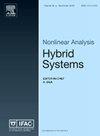肿瘤治疗中HAP给药的优化
IF 3.7
2区 计算机科学
Q2 AUTOMATION & CONTROL SYSTEMS
引用次数: 0
摘要
我们研究了Mathur等人(2024)描述和研究的肿瘤的数学模型。缺氧通常是肿瘤抵抗抗癌治疗的一个因素。然而,缺氧激活前药(HAPs)的使用将这一挑战转化为优势,在治疗中提供了潜在的益处。通过特异性靶向低氧肿瘤区域,HAPs可以提高药物递送效率,使低氧成为治疗方法中的一个有益方面。Mathur et al.(2024)对不同有限次处理组合模拟的最优调度进行了研究。优化是通过观察治疗组织来完成的。我们为边界上有控制的癌症数学模型建立了近似的充分最优性条件。以近似解的验证定理为出发点,提出数值算法。进行数值计算以优化组织内活性药物的密度。结果表明,在设定最佳控制参数的情况下,通过增加药物的注射量和降低氧浓度可以达到活性药物的最大浓度。我们参考了其他作者直接处理的模拟结果。本文章由计算机程序翻译,如有差异,请以英文原文为准。
Optimization of HAP administration in cancer therapy
We study a mathematical model of a tumor described and investigated in Mathur et al. (2024). Hypoxia is often a factor that contributes to tumor resistance against anticancer treatments. However, the use of Hypoxia-Activated Prodrugs (HAPs) turns this challenge into an advantage, offering potential benefits in treatment. By specifically targeting hypoxic tumor regions, HAPs can enhance the efficacy of drug delivery, making hypoxia a beneficial aspect in the therapeutic approach. In Mathur et al. (2024) optimal schedules for different finite number of simulation of treatment combinations is study. Optimization is done by observation of tissue under treatment. We develop approximate sufficient optimality conditions for that mathematical model of cancer with controls on the boundary. It is a starting point to present numerical algorithm with verification theorem of approximate solution. Numerical calculations are performed to optimize the density of the active drug within the tissue. The results show that the maximum density of active drugs can be achieved by increasing the injection of the drug and reducing oxygen levels, with optimal control parameters set. We refer our result to the simulations done by other authors with direct treatments.
求助全文
通过发布文献求助,成功后即可免费获取论文全文。
去求助
来源期刊

Nonlinear Analysis-Hybrid Systems
AUTOMATION & CONTROL SYSTEMS-MATHEMATICS, APPLIED
CiteScore
8.30
自引率
9.50%
发文量
65
审稿时长
>12 weeks
期刊介绍:
Nonlinear Analysis: Hybrid Systems welcomes all important research and expository papers in any discipline. Papers that are principally concerned with the theory of hybrid systems should contain significant results indicating relevant applications. Papers that emphasize applications should consist of important real world models and illuminating techniques. Papers that interrelate various aspects of hybrid systems will be most welcome.
 求助内容:
求助内容: 应助结果提醒方式:
应助结果提醒方式:


